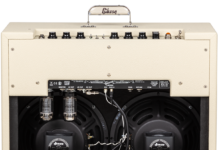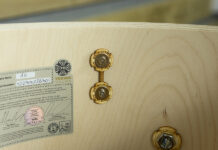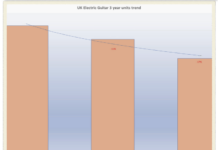Carlos Santana Teams with the Isley Brothers to Celebrate the 'Power of Peace'
Carlos Santana and the Isley Brothers…come again? Both are musical legends with long careers marked by relentless innovation. And neither act is exactly a stranger to the power of the almighty groove.
They’ve just released an album together, Power of Peace. But at first blush, the pairing might seem a little strange. Is there really a common ground there?
Those in attendance at the Las Vegas House of Blues on a recent summer evening were left in no doubt that the combination is indeed an inspired one. Nestled inside of the Mandalay Bay hotel and casino, the Vegas House of Blues has practically become Carlos Santana’s living room. Over the course of many long residencies there, he and his ace band have dialed themselves into the intimate venue’s acoustics as if the place was built just for them.
“Carlos has that rare ability to play a melody for the last guy in the last seat in the corner,” says Paul Reed Smith, who has been building guitars for Santana for several decades. “It’s that kind of guitar playing where it’s like somebody singing. And it grabs every last person in the room, even if they’re out back buying beers. He’s really good at that. When he plays, people dance, people sing and people do what music is meant to do.”
Santana himself puts it more philosophically. “The great guitarists, they don’t sound like a guitar,” he says. “They sound like life. They don’t sound like strings, chords and melodies. They’re like a big slice of life.” But the energy in the room reached a whole new level when Carlos brought singer Ronald Isley, guitarist Ernie Isley and backing vocalist Kandy Isley (Ron’s wife) onto the stage. Now in his 77th year, Ron Isley’s voice still packs a plentitude of soul power. This is the guy who sang classics like “Shout” (1959) and “Twist and Shout” (1962), songs that have become woven deep into the fabric of rock and roll repertoire.
He performed sitting on a stool at the House of Blues, but got to his feet when the spirit moved him. Resplendent in a blingy, silver sequined vest over an all-black ensemble, Isley remains the consummate showman. And his venerable voice offered the perfect complement to Santana’s own legendary guitar tone. Both are deeply steeped in the wisdom and truth that comes from decades of making musical history.
Younger sibling Ernie Isley is a more low-keyed performer, sporting shades, a black silk bandana and a beautifully inlaid Fender Custom Shop Stratocaster. A nuanced and funky rhythm player, he locks in with the band’s drummer, Cindy Blackman Santana, forging flawless grooves. “I found out Ernie played drums on a lot of the later Isley records,” she says. “So he’s got a natural groove on guitar—a nice soulful feel.
And with the two-guitar thing, it’s incredible—Carlos playing with his ferocity and liveliness, combined with that soulful vibe from both Ernie and Carlos. Ernie brings in some influences from the great guitar players he loved too. So, for me as a drummer, that’s really wonderful to play with, because it’s just funky and soulful, and you can’t lose with that.”
Are You Ready (Audio Only) by The Isley Brothers & on VEVO.
An accomplished jazz drummer who can bust out a mean Tony Williams/Billy Cobham style fusion solo, Blackman Santana can also lay down rock-solid grooves that drive the Santana band like a Lamborghini. Few jazz drummers can whack the two and four with that kind of conviction and authority. The power in Blackman Santana’s playing belies her slim, compact frame, crowned with an abundant Afro. “She’s fierce,” says Paul Reed Smith. “There’s something ferocious about her playing. She feels like a lion.”
Now in their sixth year of marriage, Carlos and Cindy are one of those close-knit couples who can finish one another’s sentences, and frequently do so. Sharing a bond that is both musical and romantic, their upbeat, collective chemistry is palpable, both onstage and off. Both were equally keen to embark on the Power of Peace project with the Isleys. The record offers fresh interpretations of songs by artists that include Stevie Wonder, Marvin Gaye, Billie Holiday, Curtis Mayfield, the Chambers Brothers, Burt Bacharach and others.
It’s a broad cross-section of both classic tunes and more deep album cuts. Most tend to be songs of freedom, empowerment and universal love—themes that resonate deeply at a time when intolerance and injustice are on the rise.
“It was a wonderful experience to work with Ernie, Ronnie and everybody,” says Carlos, “collectively sculpting these songs that we’ve known for years. But when you hear the way we do them, they don’t sound the way you heard them before. We’ve transmogrified them.”
The Isleys and Carlos Santana first crossed paths back in 1973. Santana performed at a music industry conference at CBS Records; Ron and Ernie Isley were also in attendance. The elder Isley remembers that Carlos was less than thrilled to be playing before a crowd of drunk conventioneers.
“He had his back turned to the audience and said, ‘This is for you gringos.’ And he just turned it on. Ernie and I heard him play and thought, Wow, this guy is just phenomenal.” Both Santana and the Isley Brothers were at career high points in 1973. Already hailed as the godfather of Latino rock, Santana took a headlong dive into the then-emergent jazz-rock fusion genre with 1973’s Love Devotion Surrender album, recorded with guitar master John McLaughlin.
That same year, the Isleys were on top of the charts with “That Lady, Parts 1 & 2,” a track that represented a quantum leap for them as well. A wah wah- and conga-fueled remake of an earlier record they’d released called “Who’s That Lady,” the 1973 recording is remarkable for bringing a massive dose of full-on, flangy rock guitar—played by Ernie Isley—into the R&B idiom. Santana’s influence on Isley’s lead guitar playing is clear.
“The track was highly rhythmic, funky and danceable,” Ernie recalls. “And when the guitar went on top of it, it turned into something that none of us could have expected. We put lyrics on it and said, ‘Okay, now we got a record.’ ”
The other guitarist whose influence on the track is unmistakable is Jimi Hendrix. This is hardly surprising, as Hendrix was the Isley Brothers’ guitarist from 1963 through 1965, during his pre-fame tenure as a hard-working r&b sideman. For a while, Hendrix even shared a house in New Jersey with the Isleys. Ernie was just a kid at the time, wide-eyed with admiration.
“Ten years old,” he says. “I was just starting on guitar. And of course any guitar you got around the house, you gonna be playing. Jimi too. So I’d sit around listening and observing. You never know how stuff will rub off on you.”
Ernie also remembers Hendrix being impressed when the Beatles covered the Isleys’ “Twist and Shout.” The Fab Four’s version was released in the U.S in March 1964, during Hendrix’s time with the Isleys and shortly after the Beatles’ American TV debut on the Ed Sullivan Show in February 1964. “After the Beatles performed on Ed Sullivan, there was a meeting of all the band,” Ernie recounts. “I looked over at Jimi Hendrix and said, ‘Look at that band; they got two guitar players!’ And my brother Kelly said, ‘Yeah, but we got Jimi.’ ”
Ernie, who started performing with the Isleys in the Seventies, was a key figure in the group’s transition from its initial incarnation as a vocal trio, consisting of Ron, Rudolph and O’Kelly Isley, to a self-contained band with Ernie on guitar, his brother Marvin on bass and brother-in-law Carl Jasper on keyboards. Sporting a headband and a Strat, Ernie channeled Hendrix heavily in those years.
Even his manner of speaking, in a barely audible whisper, is reminiscent of the long-departed guitar hero. “It was important at that time for the audience to know that the brothers is playin’ the music and doing all the singin’,” Ron notes. “That was the first 3 + 3 album the Isley Brothers did.” From the Seventies onward, both Santana and the Isley Brothers charted their own stellar courses through the popular music firmament, both consistently vaporizing stylistic boundaries and exploring new territories.
The groundwork for the Power of Peace album was laid a few years ago, when Ron Isley met up with Carlos and Cindy Santana backstage at a concert where Santana was opening for Rod Stewart.
“I hope I didn’t scare him,” Carlos says with a laugh, “but I was on an avalanche of, like, ‘Hey, I always wanted to work with you. I love your songs, man!’ He was reserved at first, very dignified and respectful. But the more I played his songs for him on my iPod, the more he realized that I was really, really adamant and serious about doing something with him.”
The singer was indeed impressed with Santana’s encyclopedic command of the Isley catalog. He was even more touched when Carlos revealed that the first song he and Cindy danced to after they were married was Ron’s recording of “The Look of Love” from his 2003 album, Here I Am: Isley Meets Bacharach. Shortly thereafter, Carlos was in Miami, working on what would become 2016’s Santana IV album, which reunited many members of the classic Seventies Santana lineup.
“And I get the voice inside saying, ‘Hey, why don’t you call Ronnie?” Carlos narrates. “ ‘Call him and ask him if he would sing these songs that you’re writing. And if he sings these songs, then you can do a whole album with him.’ So he sang ‘Love Makes the World Go Round’ and ‘Freedom in Your Mind’ on Santana IV, and the next thing you know, we’re doing an album together.”
“We started picking songs,” Ron elaborates. “Carlos wanted to have his whole band on the record, and I wanted to have [session keyboard ace] Greg Phillinganes. So Carlos gathered them all up and we started the record. The band and the people who were involved in the record, that’s a spiritual thing, man.” Isley adds that “Carlos picked a lot of the songs,” many culled from the guitarist’s legendarily broad and deep record collection.
“Dude, this is so funny,” Cindy recounts. “When Carlos and I first got together, I think he wanted to test the waters and see where I was at, musically. We were in his kitchen, and he said ‘Look in the cupboard.’ I said, Okay, I don’t know why he wants me to look in the cupboard. Maybe there’s some food in there.’ I look in there and it’s all CDs piled all the way up. I loved it! CDs in the kitchen, CDs everywhere. You should see his iPod collection too. I love to brag about it because it’s so incredible. I’ve got a lot of music. So when I meet somebody who has more than me, it’s amazing. His collection is like a musical rolodex. I’ll be, like, ‘I got an idea for a song that kinda reminds me of…’ He’ll say, ‘Hey baby, listen to iPod number 27.’ ”
“ ’Cause we both get haunted by that sound, that mystery melody,” Carlos explains. “Where’s that melody come from? And I usually know exactly where it is and how to access it. That’s a very good thing to have, because there’s no time-wasting.”
It was Carlos’ idea, for example, to do a version of Willie Dixon’s blues classic “I Just Want to Make Love to You.” “Ronnie confessed to me the other day, ‘You know if it wasn’t for you, I never would have done this song,’ ” says Carlos. Many artists have recorded “I Just Want to Make Love to You,” from Muddy Waters to the Rolling Stones to Foghat. But this is perhaps the first version to incorporate the main riff from Hendrix’s “Foxey Lady.”
“We were trying to get some testosterone in there,” Ernie Isley deadpans. But that was one of the key ideas behind the record—to put a new musical twist on some timeless material. “We talked about it, Cindy and I,” Carlos says. “How do we get ourselves and Ronnie out of the comfort zone? How do we do something beyond the realm of what you feel inside. We did [Curtis Mayfield’s] ‘Gypsy Woman’ more like Bob Marley and Paco de Lucia—the intro, you know? There’s a great groove, some flamenco…all that, and then it turns into a song about a gypsy woman at a campfire. Whew!” The project offered plenty of opportunity for Carlos and Ernie Isley to bond as guitar buddies.
“We were in the studio and Carlos starts playing and I hear that Santana tone,” Ernie recounts. “But now it’s the actual person who created that tone, standing right in front of me. He’s playing and I’ve got a huge grin on my face, looking at him, like, ‘Wow!’ He stops playing, points at me and I start playing. And he looks up grinning and says, ‘That sound, that tone, that’s Isley! That’s ‘Who’s That Lady.’ So from that point of view, it was a real joy.”
After all these years with a guitar in his hands, Carlos retains a youthful enthusiasm for the instrument. He’s currently working with Paul Reed Smith on a new guitar model. The company isn’t ready to release details yet.
“You can say that we made Carlos a new style of instrument that he very much likes,” is all that Smith will reveal. But Carlos, typically, is more expansive. “I’m really excited that we’re creating a new instrument that will hopefully motivate more youngsters to put the laptop aside—and the LinnDrum and Guitar Hero. Get yourself a real set of drums and real guitar and stop shuckin’ and jivin’. To me, it’s a call to arms. Get yourself a real guitar and you will see your destiny in front of you, shining and shimmering.”
Source: www.guitarworld.com













